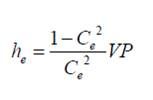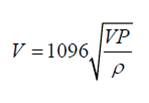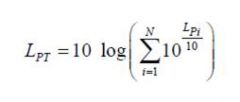![]()
![]()
![]()
Use LEFT and RIGHT arrow keys to navigate between flashcards;
Use UP and DOWN arrow keys to flip the card;
H to show hint;
A reads text to speech;
30 Cards in this Set
- Front
- Back

calculate hood entry loss for air entering a hood.
|

he = hood entry energy loss measured as a fraction of the VP ('wg)
Ce = hood entry coefficient (unitless) VP = velocity pressure ("wg) |
|

Hood static pressure
|

SPh = absolute value of SPh ('wg)
VP = velocity within a duct ("wg) he = hood entry energy loss measured as a fraction of the VP ('wg) |
|

Hood entry loss and hood entry loos coefficient
|

he = overall hood entry loss ("wg)
Fh = hood entry loss coefficient (unitless) VPd = duct velocity pressure ("wg) |
|

Coefficient of entry
|

Ce = hood flow coefficient (unitless)
VP = velocity pressure (“wg) SPh = hood static pressure (“wg) Use this for calculating the hood flow coefficient which is the ratio of the actual airflow thru the hood to the theoretical flow if there were no losses |
|

Duct velocity and density
|

V = velocity (fpm)
VP = velocity pressure ("wg) ρ = density of air in lb/ft3 density of air (at 70F =0.075lb/ft3) Use this for correcting for density (ie in the mountains) |
|

Hood flow rate and static pressure
|

Q = air flow (cfm)
Ce = hood flow coefficient (unitless) A = area (ft2) SPh = hood static pressure ("wg) Use this for calculating actual hood flows instead of using estimates aka throat suction equation |
|

Dilution ventilation: time interval for purging
|

t = time (minutes)
Vr = volume of room Q’ = effective volumetric flow rate (cfm) C = concentration (ppm) Use this for calculating contaminant concentration buildup, has to do with dilution ventilation purge time. |
|

Dilution ventilation: concentration buildup
|

G = generation rate (cfm)
Q’ = effective flow rate (cfm) C = concentration (ppm) Vroom = volume of the room (ft3) t = time (minutes) Use this for contaminant concentration buildup with dilution ventilation |
|

Dilution ventilation: steady state with generatione rate.
|

C = concentration (ppm)
G = generation rate (cfm) Q’= effective flow rate (cfm) Csupply = (ppm) Use this for steady state with generation rate |
|

Diltuion ventilation: concentration buildup, no inital concentration
|

C = concentration (ppm)
G = generation rate (cfm) Q’ = effective flow rate (cfm) N = number of ACH t = time (mins) |
|

Dilution ventilation: steady state w specific gravity
|

Q = flow rate (cfm)
sg = specific gravity ER = evaporation rate (pints/minute) K = mixing factor (ranges from 1-10, best to poor) MW = molecular weight C = concentration of TLV (ppm) |
|
|
1 pint = _ quart
|
1 pint = 0.5 quart
|
|

Dilution ventilation: steady state airborne concentration
|

C = concentration (ppm)
g = grams? MW= molecular weight V = volume (ft3) |
|

Sound pressure level
|

SPL = sound pressure level (dB)
P= measured sound pressure (Pa) Po = reference sound pressure (Pa) Reference sound pressure 20 micropascals. This is what is measured by a sound level meter |
|

Sound intensity level
|

SPL = sound pressure level (dB)
I = sound intensity (W/m2) Io = reference sound intensity (W/m2) reference sound intensity = 10^-12watts |
|

Percent dose
|

C = exposure duration (hr)
T = corresponding allowed noise exposure duration |
|

Total SPL: 2 sources
|

Ltotal = total sound pressure level.
L1, L2 = sound pressure from sources 1 and 2 |
|

Total SPL
|

Lpt = total sound pressure level generated by N sources (dB)
Lpi = individual SPL of the ith source (dB) N = number of SPL. |
|

Leq equivalent SPL
|

Leq = equivalent continuous sound level (dB)
T = observation time (hours) Li = SPL during the ith interval (dB) |
|

Directivity Index (DI)
|

DI = directivity index (dB)
Q = directivity factor, dimensionless quantity that is the measure of the degree to which sound emitted by a source is concentrated in particular directions rather than rated uniformly. Q=1 is spherical radiation, Q=2 hemisphere, Q=4 quarter of a sphere, Q=8 is 1/8th of a sphere (corner of room). |
|
|
f = c/λ
|
Frequency = wave speed / wavelength
f = 1/T = hertz c = meters per second λ = meters |
|
|
f2 = 2 f1
|
f2 = upper limit of octave band
f1 = lower limit of octave band |
|
|
WBGT with solar load:
WBGT = 0.7tnwb + 0.2tg + 0.1tdb |
WBGT = 0.7tnwb + 0.2tg + 0.1tdb
tnwb = natural wet bulb temp tg = globe temperature tdb = dry bulb temp F or C |
|
|
WBGT without solar load:
WBGT = 0.7tnwb + 0.3tg |
WBGT = 0.7tnwb + 0.3tg
tnwb = natural wet bulb temp tg = globe temperature |
|
|
Heat storage by body:
ΔS = (M – W) C R – E |
ΔS = (M – W) C R – E
S = change in amt of heat stored by body M = metabolic heat W = external work rate C = convective heat exchange R = radiative heat exchange E = evaporative heat loss All units: kcal/hr; BTU/hr |
|
|
Radiant heat gain/loss
R = 15(tw – 95) |
R = 15(tw – 95)
R = radiant heat exchange (kcal/hr;BTU/hr) tw = mean radiant temp (F) |
|
|
Convective heat gain/loss
C = 0.65v0.6 (tα – 95) |
Used for the rate of convective heat exchange between the skin of a person and the ambient air immediately surrounding the skin
C = 0.65v0.6 (tα – 95) C = convective heat exchange (kcal/hr;BTU/h) v = air velocity (fpm) ta = air temperature (F) 95 = tsk = mean weighted skin temperature |
|
|
Max evaporative heat loss
Emax = 2.4v0.6 (42 – vpw) |
Used to calculate loss of heat due to evaporation from skin
Emax = 2.4v0.6 (42 – vpw) E = evaporative heat loss (kcal/hr;BTU/h) v = air velocity (fpm) vpw = water vapor pressure of ambient air (mmHg) 42 = mmHg of water vapor pressure on skin at 95F skin temperature |
|
|
Sensible Heat Ventilation
cfm = Total Sensible Heat (BTU/hr) / 1.08(ΔT) |
cfm = Total Sensible Heat (BTU/hr) / 1.08(ΔT)
ΔT = change in temp (F) Total sensible heat = amt of heat energy that changes only the temperature and not the phyiscal state, of a substance. |
|
|
Ueat stress index
HSI = Ereq/Emax x 100 |
HSI = Ereq/Emax x 100
HSI = % Ereq = amt of evaporative heat loss possible (kcal/hr;BTU/hr) Emax = max evaporative heat loss possible (kcal/hr;BTU/hr) |

